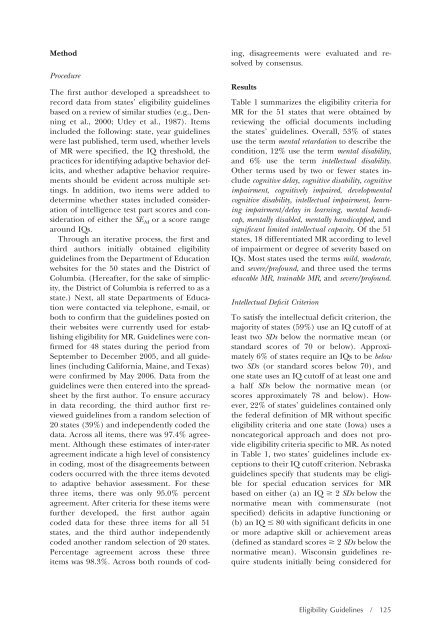Download the Journal (PDF) - Division on Autism and ...
Download the Journal (PDF) - Division on Autism and ...
Download the Journal (PDF) - Division on Autism and ...
Create successful ePaper yourself
Turn your PDF publications into a flip-book with our unique Google optimized e-Paper software.
Method<br />
Procedure<br />
The first author developed a spreadsheet to<br />
record data from states’ eligibility guidelines<br />
based <strong>on</strong> a review of similar studies (e.g., Denning<br />
et al., 2000; Utley et al., 1987). Items<br />
included <str<strong>on</strong>g>the</str<strong>on</strong>g> following: state, year guidelines<br />
were last published, term used, whe<str<strong>on</strong>g>the</str<strong>on</strong>g>r levels<br />
of MR were specified, <str<strong>on</strong>g>the</str<strong>on</strong>g> IQ threshold, <str<strong>on</strong>g>the</str<strong>on</strong>g><br />
practices for identifying adaptive behavior deficits,<br />
<strong>and</strong> whe<str<strong>on</strong>g>the</str<strong>on</strong>g>r adaptive behavior requirements<br />
should be evident across multiple settings.<br />
In additi<strong>on</strong>, two items were added to<br />
determine whe<str<strong>on</strong>g>the</str<strong>on</strong>g>r states included c<strong>on</strong>siderati<strong>on</strong><br />
of intelligence test part scores <strong>and</strong> c<strong>on</strong>siderati<strong>on</strong><br />
of ei<str<strong>on</strong>g>the</str<strong>on</strong>g>r <str<strong>on</strong>g>the</str<strong>on</strong>g> SE M or a score range<br />
around IQs.<br />
Through an iterative process, <str<strong>on</strong>g>the</str<strong>on</strong>g> first <strong>and</strong><br />
third authors initially obtained eligibility<br />
guidelines from <str<strong>on</strong>g>the</str<strong>on</strong>g> Department of Educati<strong>on</strong><br />
websites for <str<strong>on</strong>g>the</str<strong>on</strong>g> 50 states <strong>and</strong> <str<strong>on</strong>g>the</str<strong>on</strong>g> District of<br />
Columbia. (Hereafter, for <str<strong>on</strong>g>the</str<strong>on</strong>g> sake of simplicity,<br />
<str<strong>on</strong>g>the</str<strong>on</strong>g> District of Columbia is referred to as a<br />
state.) Next, all state Departments of Educati<strong>on</strong><br />
were c<strong>on</strong>tacted via teleph<strong>on</strong>e, e-mail, or<br />
both to c<strong>on</strong>firm that <str<strong>on</strong>g>the</str<strong>on</strong>g> guidelines posted <strong>on</strong><br />
<str<strong>on</strong>g>the</str<strong>on</strong>g>ir websites were currently used for establishing<br />
eligibility for MR. Guidelines were c<strong>on</strong>firmed<br />
for 48 states during <str<strong>on</strong>g>the</str<strong>on</strong>g> period from<br />
September to December 2005, <strong>and</strong> all guidelines<br />
(including California, Maine, <strong>and</strong> Texas)<br />
were c<strong>on</strong>firmed by May 2006. Data from <str<strong>on</strong>g>the</str<strong>on</strong>g><br />
guidelines were <str<strong>on</strong>g>the</str<strong>on</strong>g>n entered into <str<strong>on</strong>g>the</str<strong>on</strong>g> spreadsheet<br />
by <str<strong>on</strong>g>the</str<strong>on</strong>g> first author. To ensure accuracy<br />
in data recording, <str<strong>on</strong>g>the</str<strong>on</strong>g> third author first reviewed<br />
guidelines from a r<strong>and</strong>om selecti<strong>on</strong> of<br />
20 states (39%) <strong>and</strong> independently coded <str<strong>on</strong>g>the</str<strong>on</strong>g><br />
data. Across all items, <str<strong>on</strong>g>the</str<strong>on</strong>g>re was 97.4% agreement.<br />
Although <str<strong>on</strong>g>the</str<strong>on</strong>g>se estimates of inter-rater<br />
agreement indicate a high level of c<strong>on</strong>sistency<br />
in coding, most of <str<strong>on</strong>g>the</str<strong>on</strong>g> disagreements between<br />
coders occurred with <str<strong>on</strong>g>the</str<strong>on</strong>g> three items devoted<br />
to adaptive behavior assessment. For <str<strong>on</strong>g>the</str<strong>on</strong>g>se<br />
three items, <str<strong>on</strong>g>the</str<strong>on</strong>g>re was <strong>on</strong>ly 95.0% percent<br />
agreement. After criteria for <str<strong>on</strong>g>the</str<strong>on</strong>g>se items were<br />
fur<str<strong>on</strong>g>the</str<strong>on</strong>g>r developed, <str<strong>on</strong>g>the</str<strong>on</strong>g> first author again<br />
coded data for <str<strong>on</strong>g>the</str<strong>on</strong>g>se three items for all 51<br />
states, <strong>and</strong> <str<strong>on</strong>g>the</str<strong>on</strong>g> third author independently<br />
coded ano<str<strong>on</strong>g>the</str<strong>on</strong>g>r r<strong>and</strong>om selecti<strong>on</strong> of 20 states.<br />
Percentage agreement across <str<strong>on</strong>g>the</str<strong>on</strong>g>se three<br />
items was 98.3%. Across both rounds of cod-<br />
ing, disagreements were evaluated <strong>and</strong> resolved<br />
by c<strong>on</strong>sensus.<br />
Results<br />
Table 1 summarizes <str<strong>on</strong>g>the</str<strong>on</strong>g> eligibility criteria for<br />
MR for <str<strong>on</strong>g>the</str<strong>on</strong>g> 51 states that were obtained by<br />
reviewing <str<strong>on</strong>g>the</str<strong>on</strong>g> official documents including<br />
<str<strong>on</strong>g>the</str<strong>on</strong>g> states’ guidelines. Overall, 53% of states<br />
use <str<strong>on</strong>g>the</str<strong>on</strong>g> term mental retardati<strong>on</strong> to describe <str<strong>on</strong>g>the</str<strong>on</strong>g><br />
c<strong>on</strong>diti<strong>on</strong>, 12% use <str<strong>on</strong>g>the</str<strong>on</strong>g> term mental disability,<br />
<strong>and</strong> 6% use <str<strong>on</strong>g>the</str<strong>on</strong>g> term intellectual disability.<br />
O<str<strong>on</strong>g>the</str<strong>on</strong>g>r terms used by two or fewer states include<br />
cognitive delay, cognitive disability, cognitive<br />
impairment, cognitively impaired, developmental<br />
cognitive disability, intellectual impairment, learning<br />
impairment/delay in learning, mental h<strong>and</strong>icap,<br />
mentally disabled, mentally h<strong>and</strong>icapped, <strong>and</strong><br />
significant limited intellectual capacity. Of <str<strong>on</strong>g>the</str<strong>on</strong>g> 51<br />
states, 18 differentiated MR according to level<br />
of impairment or degree of severity based <strong>on</strong><br />
IQs. Most states used <str<strong>on</strong>g>the</str<strong>on</strong>g> terms mild, moderate,<br />
<strong>and</strong> severe/profound, <strong>and</strong> three used <str<strong>on</strong>g>the</str<strong>on</strong>g> terms<br />
educable MR, trainable MR, <strong>and</strong> severe/profound.<br />
Intellectual Deficit Criteri<strong>on</strong><br />
To satisfy <str<strong>on</strong>g>the</str<strong>on</strong>g> intellectual deficit criteri<strong>on</strong>, <str<strong>on</strong>g>the</str<strong>on</strong>g><br />
majority of states (59%) use an IQ cutoff of at<br />
least two SDs below <str<strong>on</strong>g>the</str<strong>on</strong>g> normative mean (or<br />
st<strong>and</strong>ard scores of 70 or below). Approximately<br />
6% of states require an IQs to be below<br />
two SDs (or st<strong>and</strong>ard scores below 70), <strong>and</strong><br />
<strong>on</strong>e state uses an IQ cutoff of at least <strong>on</strong>e <strong>and</strong><br />
a half SDs below <str<strong>on</strong>g>the</str<strong>on</strong>g> normative mean (or<br />
scores approximately 78 <strong>and</strong> below). However,<br />
22% of states’ guidelines c<strong>on</strong>tained <strong>on</strong>ly<br />
<str<strong>on</strong>g>the</str<strong>on</strong>g> federal definiti<strong>on</strong> of MR without specific<br />
eligibility criteria <strong>and</strong> <strong>on</strong>e state (Iowa) uses a<br />
n<strong>on</strong>categorical approach <strong>and</strong> does not provide<br />
eligibility criteria specific to MR. As noted<br />
in Table 1, two states’ guidelines include excepti<strong>on</strong>s<br />
to <str<strong>on</strong>g>the</str<strong>on</strong>g>ir IQ cutoff criteri<strong>on</strong>. Nebraska<br />
guidelines specify that students may be eligible<br />
for special educati<strong>on</strong> services for MR<br />
based <strong>on</strong> ei<str<strong>on</strong>g>the</str<strong>on</strong>g>r (a) an IQ 2 SDs below <str<strong>on</strong>g>the</str<strong>on</strong>g><br />
normative mean with commensurate (not<br />
specified) deficits in adaptive functi<strong>on</strong>ing or<br />
(b) an IQ 80 with significant deficits in <strong>on</strong>e<br />
or more adaptive skill or achievement areas<br />
(defined as st<strong>and</strong>ard scores 2 SDs below <str<strong>on</strong>g>the</str<strong>on</strong>g><br />
normative mean). Wisc<strong>on</strong>sin guidelines require<br />
students initially being c<strong>on</strong>sidered for<br />
Eligibility Guidelines / 125
















